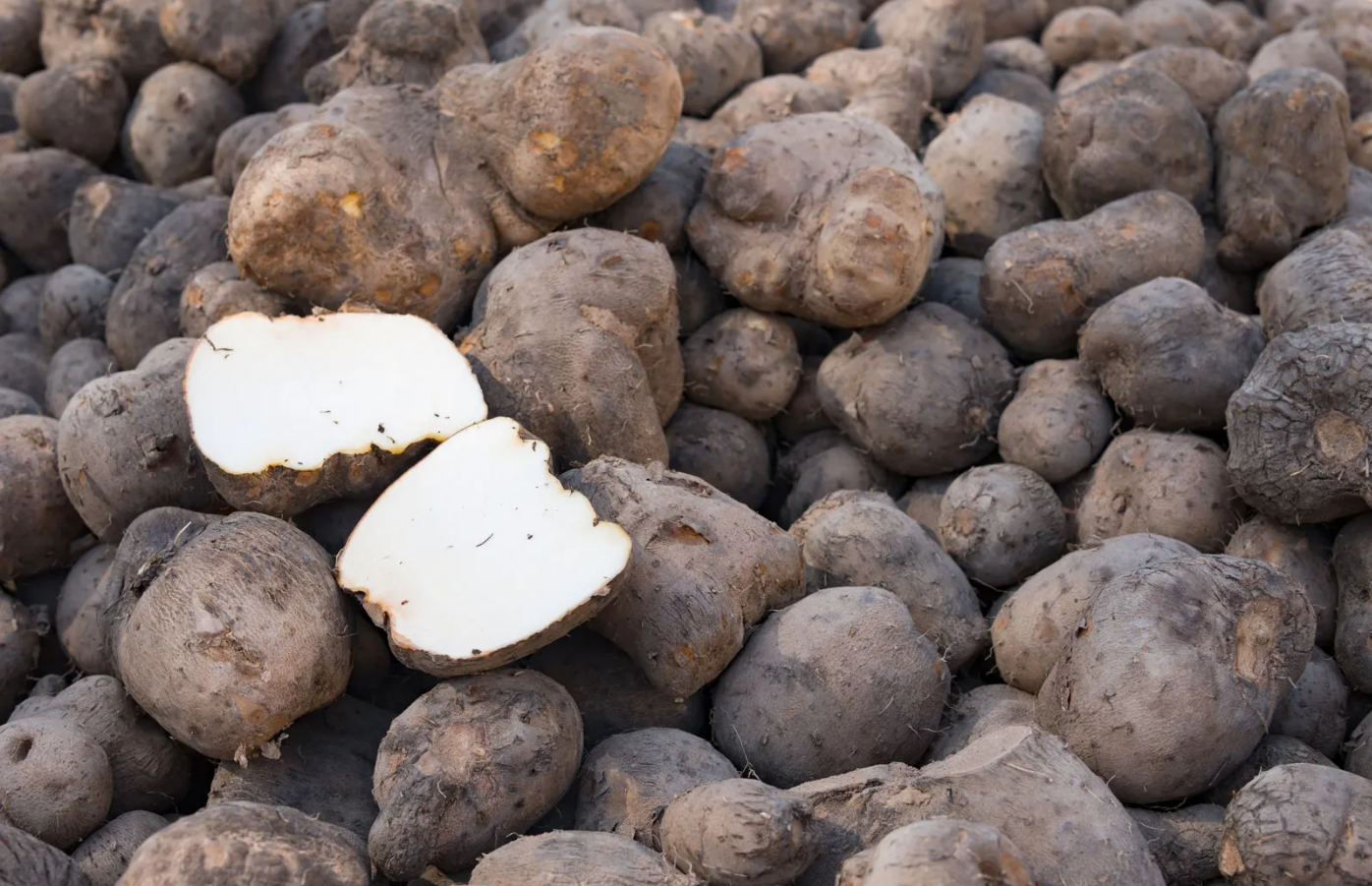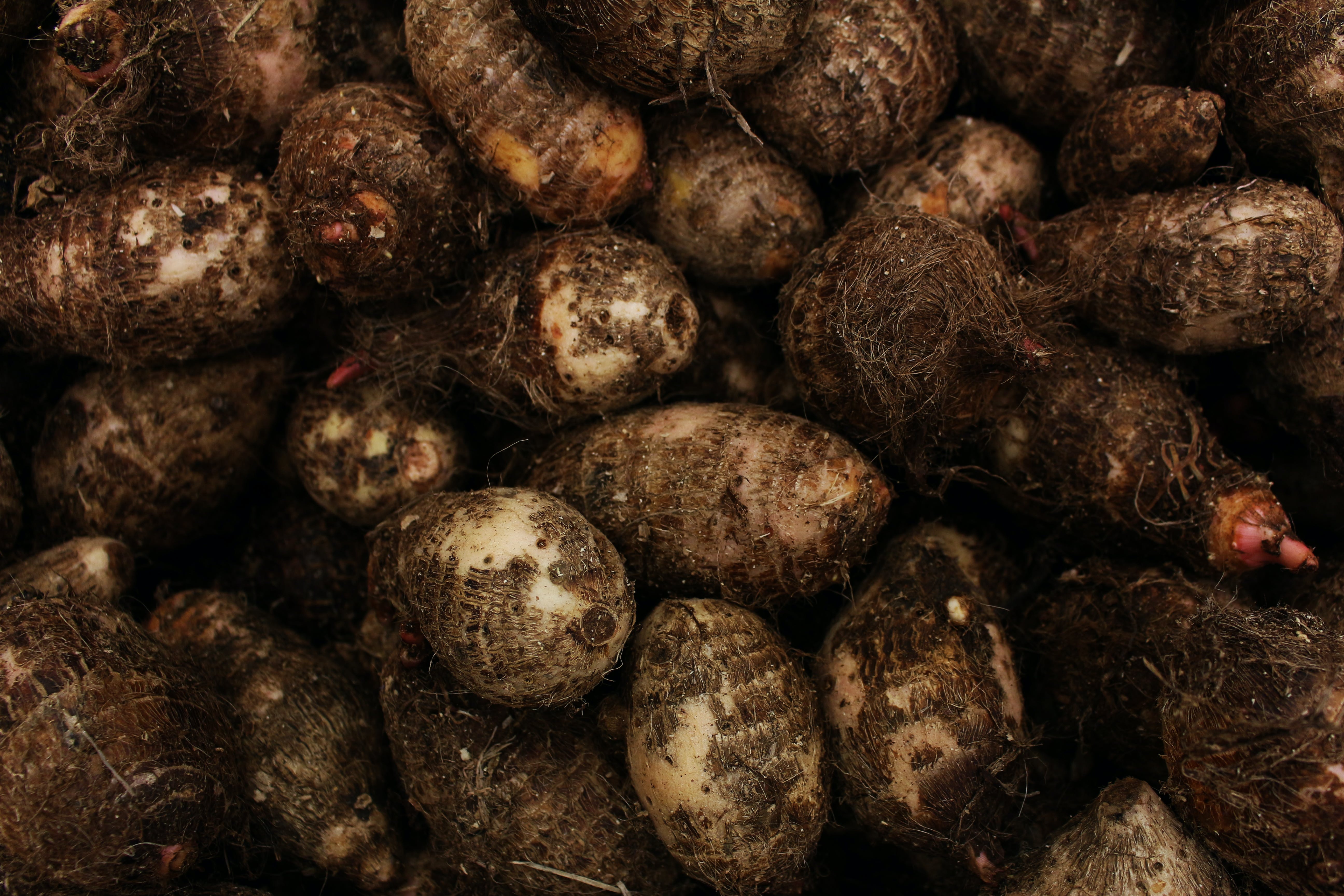Yam: History, uses, and plant information

This post is also available in:
This post is also available in:
![]() Español (Spanish)
Español (Spanish)
Origin and dispersion of yam
Yams (Dioscorea spp.) are flowering plants of the Dioscoreaceae family. It includes more than 600 species of woody shrubs and climbing vines. They are underground tubers with heart-shaped leaves, tiny green or white blooms, and berry–shaped fruit. Yams are extensively spread throughout the tropical and warm temperate parts of the planet. However, human translocations have likely impacted their current geographic distribution. This tuber crop is grown in Africa, Asia, South and Central America, the Caribbean, and the South Pacific islands.

Artifacts dating from about 50,000 BC show evidence of wild yams being used for sustenance in West Africa before that time. This shows that yams have been our ancestors’ steadfast source of nourishment. Yam cultivation appears to have developed independently in two regions, in West Africa and Southeast Asia, about 3000 BC. According to some accounts, Dioscorea rotundata, a common yam species, was domesticated for the first time in West Africa around 5000 BC. The origin of yams is not bound to West Africa alone, as some research shows they also originated from Southeast Asia and tropical America. Today, yam cultivation is a widespread practice in the tropics, found globally, primarily within the “yam belt,” a region a few degrees to the north and south of the equator that provides the ideal climate and conditions for yam growth.
Description of yam crop and its species
Yam is part of the family of roots and tubers whose edible parts are found underground. Yam plants are known to produce thick tubers at the base of the stem, which store all the nutrients produced by the plant. The part of the plant that grows above the ground is long and slender, with stems that grow while climbing. Therefore, it is essential to use supporting structures like sticks and poles to stake the yam so the stems do not grow on the ground. Staking also increases the size of the tuber that grows underground. Yam tubers are root vegetables with scaly brown skin with white, purple, or red flesh and starchy and usually dry. Yam can produce one tuber or more depending on the species, and these tubers can be cylindrical, curved, or lobed with colors such as brown, grey, black, or pink skin with white, orange, or purple flesh.

Yams can be produced as annual plants and harvested after a season. In contrast, some can be made over years, with tubers increasing each year and the vines dying back at the end of one growing season and growing back once the conditions become favorable. Dioscorea spp has more than 800 species, though not all of them are cultivated. Let us look at some of the major species that are cultivated.
Some of the significant species of yam include the Indian yam, known by its scientific name (Dioscorea trifida), and the winged or water yam (Dioscorea alata) are the most common species of yam and are among the edible species. They are widely spread in the tropical and subtropical areas. Guinea yam, known by its scientific name Dioscorea rotundata, is mainly grown in West Africa with another species known as Dioscorea canyenensis or by its common name, yellow guinea yam. Dioscorea esculenta known by its common name as Lesser yam, is grown on the subcontinent of India, on the South Pacific islands, and in Vietnam. It is one of the tastiest yams that can be cultivated. Dioscorea polystachya , known as Cinnamon vine and Chinese yam, is cultivated in East Asia. Dioscorea bulbifera, Air yam is also one of the most important species in the family Dioscoreaceae and is native to Africa, Asia, and northern Australia. It is important to note that the common names of yam may differ from one place to another based on the language.
How do we use yam?
Consumption
Yam is one of the most significant food crops in tropical climates. It enhances food security and is a primary source of Carbohydrates and fiber for millions of people in the world’s tropical and sub–tropical regions. Reports have shown that yams are a staple food in parts of India, South America, and Ethiopia, specifically the Shewa District. Several studies have documented its importance in West Africa as a staple food source.
Medicinal
- Secondary metabolites found in the tubers, including diosgenin, which has a molecular structure like steroidal hormones, have been used to synthesize steroids to make birth control pills.
- Yams are rich in thiocyanate, a substance that prevents human sickle cell anemia.
- The tubers benefit human health by providing essential proteins and micronutrients, such as vitamin C in D. rotundata, and a lot of potassium.
- Yam products are utilized as a traditional cure to treat impotence in sympathetic medicine on some Japanese islands.
- Diabetes is treated with bitter yam (D. dumetorum) products due to their propensity to reduce blood sugar levels.
- They are utilized in local cultures to treat rheumatoid arthritis, stomach pain, menstrual irregularities, and schistosomiasis, a parasitic disease.
- Dioscorea batatas, a species known to be cultivated solely in China (locally called ‘Shanyao’), are used in anthroposophist medicine.
Socio-economic and cultural function
Its ownership and cultivation are mostly linked to gender and class, emphasizing “male achievement” and “social prestige.” In many West African countries such as Nigeria and other tropical African countries, yam is the most favorite food. It has a purpose in social functions such as marriage and other traditional ceremonies and rituals. Yam cultivation is a significant source of income for many people in production areas. Many people work on farms and in other parts of the value chain. Yam is a social, economic, and cultural crop for the serious-minded and robust members of society and is a traditional symbol of social status and authority.
Crop performance
Yam production 2007 was 52 million tons, with Africa contributing 96%. This is because most of the world’s production is done in West Africa, representing a production rate of 94%, and Nigeria alone contributes about 71% of yam production, more than 37 million tons. The amount of yam imported by African countries is less than that of yam exported. Despite all this, yam production keeps reducing in some areas known to produce yam due to declining soil fertility and increasing pressures from pests and production costs. These challenges mainly affect smallholder farmers, who are the primary producers.
Production systems of yam crop
Mono cropping
When cultivating as a mono-crop, yam is planted in rows, keeping an interrow and intercrop spacing depending on the farmer’s desires, and it is planted without mixing it with another crop. Regarding spacing, if the farmer wants to have big-sized tubers at harvest time, the spacing should be increased, but if the farmer wants to have smaller-sized tubers, then the space should be reduced.
Intercropping
In an intercropping system, yam is cultivated in association with other crops. It is essential that the farmer selects crops that will be beneficial to the yam, such as leguminous plants, and the number and types of associated crops determine the distance between them.
Agroforestry System
In an agroforestry system, Yam is cultivated in association with trees that act as living stakes for the yam stems that need to be staked. In addition to staking, trees can also help fix nitrogen in the soil, depending on the type of tree used. In this system, it is crucial to start by planting the trees before the Yam or having the trees in place before the yam because as soon as Yam stems start growing, they need to be staked. The trees used must be compatible with Yam.
References:
- https://www.appropedia.org/Root_Crops/Yam_(Dioscorea_spp.)
- https://www.britannica.com/plant/yam
- https://www.ogidiolufarms.com/staking-the-yam-vines/
- https://dpi.wi.gov/sites/default/files/imce/school-nutrition/pdf/fact-sheet-yam.pdf
- https://www.finelib.com/
- https://foodeely.com/why-are-yams-important-in-nigeria/
- https://www.narayanahealth.org/
- https://www.iita.org/cropsnew/dioscoria/#1620987701664-c20ac051-64ff
- https://www.intechopen.com/chapters/83160
- https://www.researchgate.net/publication/312231378_Yam_Dioscorea_spp
- http://usi.earth.ac.cr/glas/sp/Output.pdf
- http://www.platicar.go.cr/images/buscador/documents/pdf/2021/Manual_ame_min_ed.pdf









































































